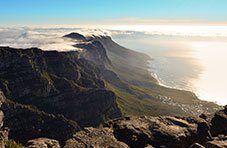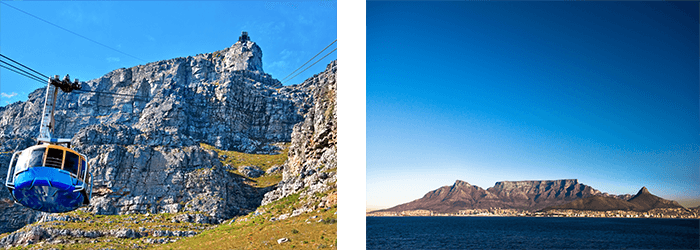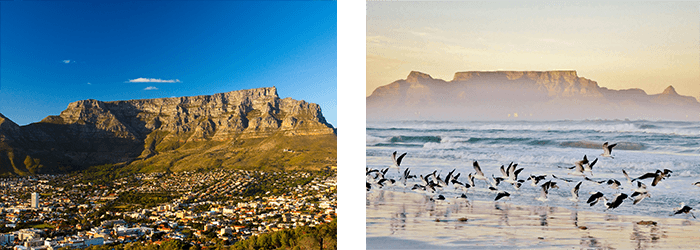Enjoy your time at Springbok Casino
Table Mountain - Majestic and Diverse

Table Mountain is the highest point of a 50 km long Cape Fold Mountain range, topped by a 3 km wide level plateau which is edged by steep cliffs. With Devil’s Peak and Lion’s Head on its east and west flanks respectively, the mountain creates a dramatic backdrop to the city of Cape Town and its beaches.
Counting more than 500 million years of age, Table Mountain is a senior to all of the major mountain ranges of the world and has been a witness to the birth and extinction of dinosaurs. It now boasts the status of UNESCO World Heritage Site and a title of one of the world’s New Seven Wonders. The mountain is part of the Table Mountain National Park which was originally known as the Cape Peninsula National Park, proclaimed by the president Nelson Mandela in 1998. This is a great destination for all who love nature as it contains a truly unique fauna and flora. Standing at its top, 1 kilometre above sea level, you get to experience one of the most spectacular views in the whole of Africa - Cape Town, Table Bay and Robben Island lying on the north, and the Atlantic seaboard on the west and south.

Depending on which side you look at, you’ll be met by a very different view. On the north, bare sheer cliffs; indigenous forest on the flourishing eastern side and a forested and undisturbed valley on the back; finally, framed by a series of peaks called the Twelve Apostles which overlook the ocean on the west. Its flat top is frequently covered by clouds which form the so-called "table cloth". According to the legend, this phenomenon is a sign of a smoking contest taking place between the Devil and a local pirate Van Hunks.
Once an island, Table Mountain is today one of the most photographed places in the whole world. Offering numerous trails and amazing views, hiking on the mountain is hugely popular amongst both the locals and the tourists. Since it was opened almost 100 years ago, the Table Mountain Cableway has taken more than 22 million people to its 1,067 meters high top.
The mountain hides several large cave systems, some of its caves inhabited by the Sakmanne, or Sackcloth People. Having made Table Mountain their home, Sakmanne live off the vegetation they forage and visit Cape Town to trade medicinal herbs, roots and plants.
The Incredible Wildlife at Table Mountain
Table Mountain displays an unusually rich biodiversity with more than 2,200 endemic species of plants. The Disa uniflora, a beautiful orchid, is a pretty common sight in wet areas, such as near waterfalls and streams. It blooms in scarlets and pinks during summer months and has been the logo of Mountain Club since its founding in 1891. The mountain’s vegetation consists primarily of various and unique types of Cape fynbos, belt of natural shrubland which forms part of the Cape floral kingdom. It’s interesting to know fire is an important driver of fynbos diversity, and the plants it’s made of today are the result of various fire regimes over the past 12,000 years.

Kirstenbosch Botanical Gardens situated on the east side of the mountain has the reputation of being the most beautiful garden in Africa. It’s also the first botanical garden which has been made part of a natural World Heritage Site. The Gardens show off a variety of unique plant life, including sugarbushes which add colour to mountain slopes in winter months and have been celebrated by an old Afrikaans love song: Suikerbossie, ek wil jou he... (Sugarbush, I want you). You can also spot pincushions, the evergreen shrubs with clusters of flowers which give it its name. Numerous plants from various South African biomes are also grown in Kirstenbosch Garden, including the world oldest seed plants, cycads, known for their sharp, spiky leaves.
The most common mammal to walk Table Mountain’s slopes was dassie or rock badger. These small mountain inhabitants look a bit like guinea pigs and reportedly use sentries to spot predators approaching and issue alarms. The Table Mountain ghost frog is a rare endemic species adapted for life in mountain streams. It possesses sucker-like mouth which is used to climb up wet, vertical rock surfaces. Rooikat is wild cat native to Africa, typically nocturnal and therefore difficult to spot.
Overall, the amount of wildness Table Mountain has managed to maintain despite being only 4 kilometres from the city centre, is really amazing. Wonderfully wild, ancient and offering breathtaking sights, Table Mountain has definitely deserved a spot among the world’s new seven wonders. You’ll be sure to agree as you stand 1 kilometre above sea level, taking a lungful of crisp mountain air in complete silence, while a wonderful sight meets your eye whichever way you turn.



